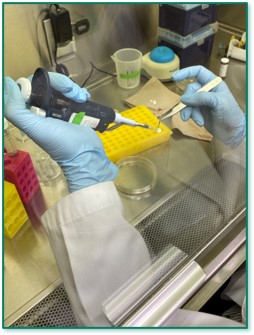Antibiotic Susceptibility Testing
Antibiotics are chemicals that inhibit bacterial growth (1). Antibiotic susceptibility testing is one of the ways scientists, including the microbiologists at Oak Crest, test the effectiveness of potential antibiotic and anti-microbial substances. In the lab, we apply a known amount of a potential antibiotic to a bacterial plate in a localized area. After allowing the bacteria to incubate and grow, we can visually identify whether our antibiotic chemicals have created ”inhibition zones,” or areas of no bacterial growth (2). The relative sizes of these inhibition zones can be measured and used to compare either the effectiveness of various antibiotics against a single type of bacteria, or a single antibiotic against different types of bacteria. Larger inhibition zones indicate greater susceptibility of the bacteria to your antibiotic of choice.

10 ul of an antibiotic solution is pipetted onto a clean filter disc

The antibiotic-dosed filter disc is placed onto an even “lawn” of bacteria grown in an agar plate.

Agar plates cultured with E. coli bacteria and treated with varying concentrations of bleach for antibiotic susceptibility testing at Oak Crest Institute of Science.

Yellow arrows indicate the inhibition zones where bacterial growth is stopped by the antibiotic. A larger zone indicates stronger inhibition. No inhibition is either a sign that the dose was too small or that the bacterium is resistant to the antibiotic.
Antibiotic Resistance
Antibiotic susceptibility testing allows scientists to qualitatively determine which substances might be good candidates for medicinal and industrial applications (3). Unfortunately, because bacteria can respond to their environment, they can also develop antibiotic resistance. This occurs when bacteria have had a constant (usually low-level) exposure to an antibiotic and develop resistance against it. This is problematic because a normally effective antibiotic is no longer sufficient to kill the bacteria, and stronger antibiotics or higher doses may be necessary to fight the infection (4). Some “super bugs” are very difficult, and sometimes impossible to treat as they have developed resistance to several different antibiotics (5). This is why it is important to take all the antibiotics prescribed if you are treating a bacterial infection (6).
References:
- https://en.wikipedia.org/wiki/Antibiotic
- https://microchemlab.com/test/zone-inhibition-test-antimicrobial-activity
- https://www.ncbi.nlm.nih.gov/books/NBK539714/
- https://www.cdc.gov/drugresistance/about.html
- https://en.wikipedia.org/wiki/Antimicrobial_resistance
- https://www.cdc.gov/antibiotic-use/community/about/can-do.html
